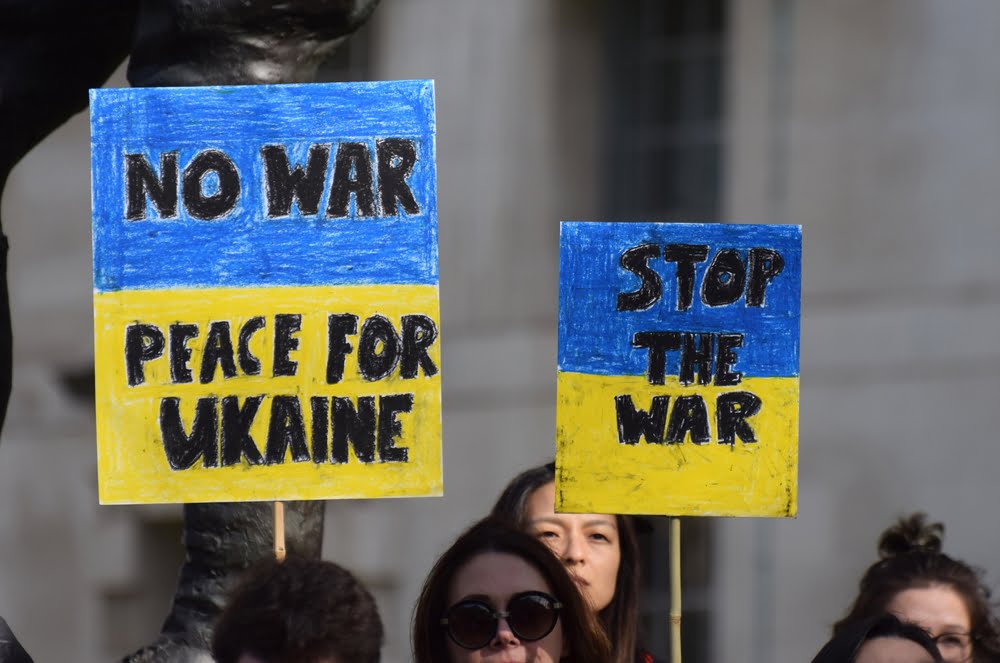It will be one year Friday since Vladimir Putin sent Russian troops into Ukraine, expecting a lightning victory that would end Kiev’s independence and reunite Ukraine with Russia. The unexpected courage and tenacity of the Ukrainians and the unexpected weakness and incompetence of Russian forces, coupled with the infusion of billions of dollars of advanced military equipment from the U.S. and NATO, have shattered Putin’s expectations.
But the war has already left a path of death and destruction in Ukraine. It has displaced a third of the country’s population of 44 million. Ukrainian officials also say more than 9,000 civilians have been killed. Tens of thousands of Ukrainian and Russian combatants have been killed. Ukrainian cities, towns, villages, and infrastructure have been devastated. The estimated cost of reconstruction is approaching the $500 billion mark. And continuation of the war not only threatens more of the same, but also a wider and even more catastrophic conflict that does not rule out the use of nuclear weapons.
Though the war continues, with most analysts not expecting it to end anytime soon, diplomatic initiatives are beginning to appear. Ukraine itself is sponsoring a new resolution at the UN General Assembly this week that includes a peace plan, but on terms that amount to a complete Russian surrender. Russia reportedly may introduce its own resolution at the UN.
Potentially more important, Chinese President Xi Jinping is expected to present a peace plan in a speech at the UN on Friday. Both the U.S. and Ukraine have expressed skepticism at the Chinese initiative, which reportedly will call for a ceasefire, respect for territorial integrity, and an end to arms shipments to Ukraine, but the Chinese move is at least encouraging as a recognition of the mounting global cost of the war, including to the Chinese economy, and a growing conviction on the need for a negotiated settlement.
The moves at the UN this week will not achieve an immediate breakthrough, but the activity at least draws attention to the diplomatic arena and it raises the question of what a realistic negotiated solution to the war might look like. It is not all that hard to imagine such a solution, one that does not reward Vladimir Putin’s aggression and at the same time does not pose a credible threat to Russian interests but gives Moscow a way to stand down.
The kernel of a negotiated settlement appeared for a moment shortly after Russia’s invasion began a year ago. Ukrainian President Volodymyr Zelenskyy publicly declared at least once that Ukraine would be willing to accept neutral status and forego membership in NATO. President Putin indicated to Turkish officials trying to broker a ceasefire and peace agreement that Ukrainian neutrality and recognition of the situation on the ground prior to the invasion would secure Russian national interests.
The year of deadly and devastating conflict has produced many complicating pressures, but the basic trade-off of formal Ukrainian neutrality for Russian withdrawal remains valid and is likely to be essential to any negotiated settlement. A stable and lasting peace, however, will require agreement on supporting elements elaborating on the basic exchange of neutrality for withdrawal.
Here is one outline of a negotiated agreement that would not reward aggression and be far, far better than continuation of the war. A resolution along lines like these would do much to restore the international order imperiled by the conflict over Ukraine and Russia’s invasion. An agreement should include:
An immediate ceasefire: A ceasefire is almost a necessary condition for further negotiations.
Withdrawal of all military forces to positions prior to February 24, 2022: This would leave Russian forces in Crimea and Russian-supported forces in the Donbas but it will restore other areas to Ukrainian government control. It may not be ideal, but it should be sufficient to set the stage for critical referenda allowing Ukrainians to exercise their right to self-determination.
Internationally supervised referenda throughout Ukraine, including the Donbas and Crimea, to determine the populations’ desire to be 1) integrated into Ukraine, 2) autonomous within Ukraine, 3) integrated into Russia, or 4) autonomous within Russia. The parties should agree to an international presence, including, if necessary, an international police presence, sufficient to guarantee free and fair referenda after a period of unhindered campaigning by the interested parties.
There should be no more internal or international opposition to the outcomes of the Ukrainian referenda than to a referendum in Scotland choosing to leave or remain in the United Kingdom. The surest way to avoid future conflict is to refrain from coercing the choices of the populations most concerned.
International guarantees of Ukrainian security and neutrality including prohibition of all foreign troops on Ukrainian soil, but not precluding closer Ukrainian economic ties with the European Union and any country willing to contribute to the massive task of Ukrainian reconstruction.
Agreement to pursue alternatives to NATO expansion to enhance European and global Security, as recommended in 1997 by a group of fifty prominent foreign policy experts that included former senators, retired military officers, diplomats, and academicians, among them former Defense Secretary Robert McNamara and former NATO Southern Commander and CIA Director Admiral Stansfield Turner.
In a June 26, 1997, letter to President Bill Clinton the group termed NATO expansion “a policy error of historic proportions … [that] will decrease allied security and unsettle European stability.” Twenty-six years after the initial expansion of NATO, the group’s judgment has proved all too prescient. Their advice to, among other things, to develop an enhanced Partnership for Peace program, pursue arms reduction treaties, and work for NATO-Russia cooperation is as relevant now as it was then. Even if NATO-Russia cooperation is impossible under current conditions, work to prepare for a future where it is will greatly help to secure European and global peace.
These or similar steps can end the war and in short order restore stability in Europe. In the middle term they can also create conditions conducive to constructive change in Russia, ultimately restoring the lost promise of peace that attended the end of the Cold War forty-four years ago.
The Biden Administration seems far from embracing anything like these goals to end Russia’s war in Ukraine, however, and move on to a new era in European security. Its silence on diplomacy poses a double threat. On the one hand, it risks signaling to Moscow that there is no alternative to continuing its war. On the other, it risks signaling to an American public beginning to question the cost of aid to Ukraine that the Administration is embarked on a crusade without a plausible path to an acceptable end game. Administration silence on diplomatic options is likely to spur Russia to escalate and to turn domestic opinion against support for Ukraine. Neither of these developments would be good for Ukraine.
If the Biden Administration remains bent on military action and silent on diplomacy can the political will be found to change U.S. policy? So far, few quarters of the U.S. peace movement have been speaking above a whisper on Ukraine. Calls for diplomacy are common, but they lack the specifics to give them force. The relative silence is not surprising. The peace movement is primed to respond to U.S. actions. This isn’t Vietnam, Afghanistan, or the second Iraq war where it was the U.S. that initiated large-scale military action. Russia’s invasion of Ukraine and its brutal conduct of the war, replete with major war crimes, looks much more like the challenge posed by Hitler’s Germany than any other recent conflict. The U.S. policy required to stand up to this kind of aggression and at the same time achieve peace and stability is harder to see. But as evidence grows that the Biden Administration is not seeking an early end to the war on terms that protect Ukraine, but at the same time open an exit door for Russia, peace groups are becoming more active.
If the Biden Administration and Congress fail to work―publicly and behind the scenes―for a ceasefire and a lasting agreement along realistic lines, an effective peace movement will be needed to steer U.S. policy toward peace and away from a longer, wider, and more catastrophic war.






